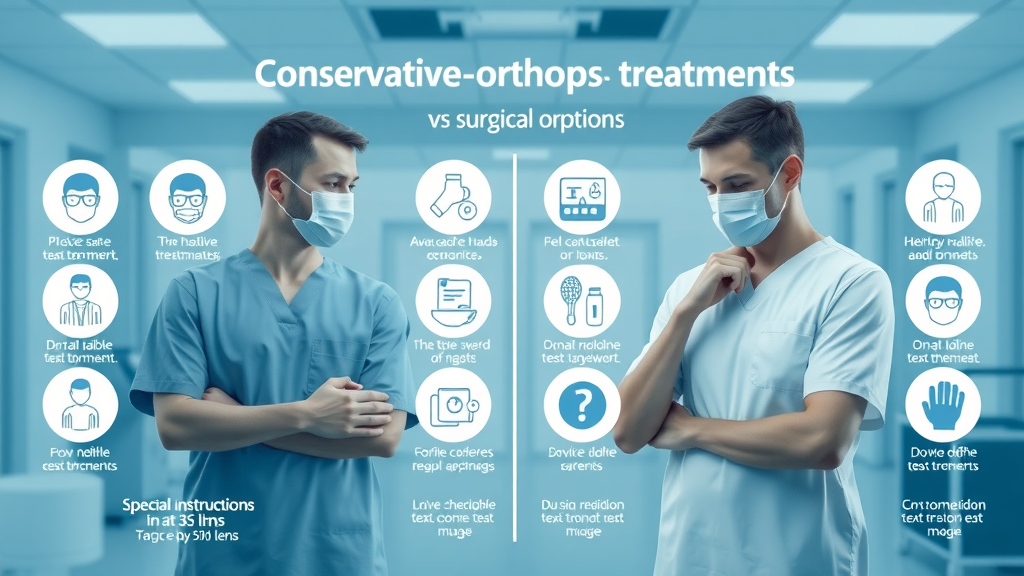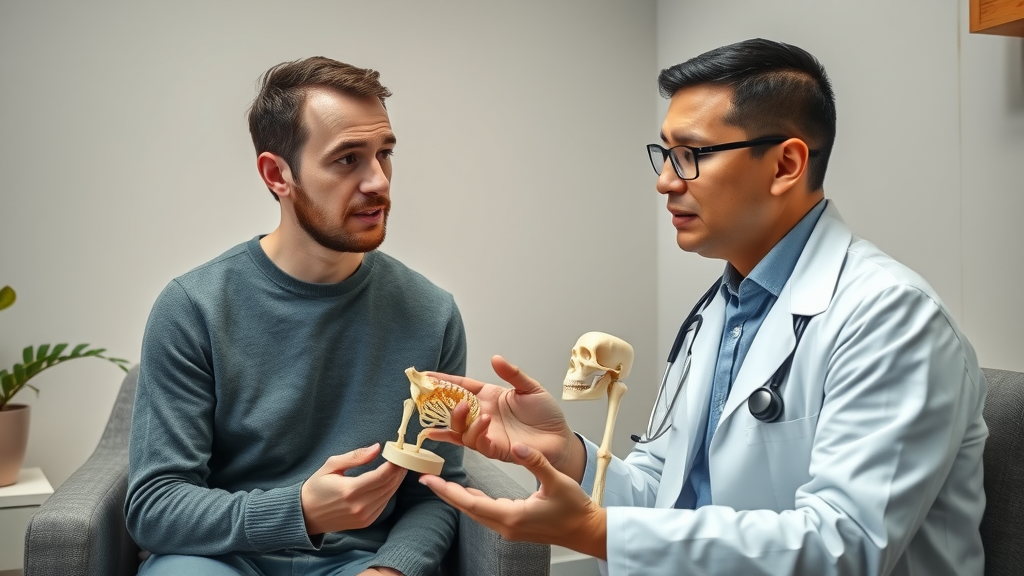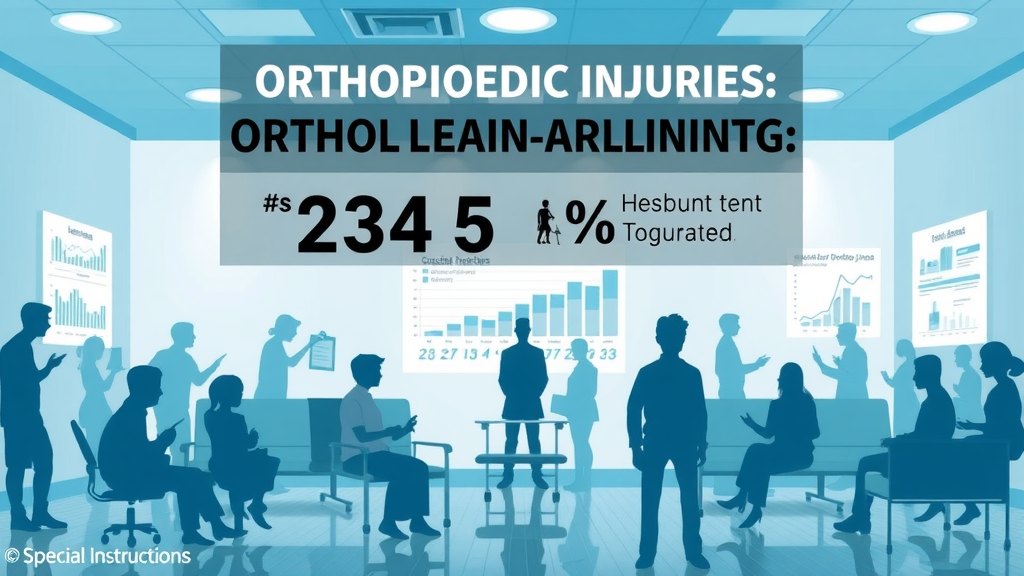Did you know that many orthopedic conditions can be effectively managed without surgery? More patients today are opting for conservative orthopedic treatment to avoid the risks, costs, and lengthy recovery periods associated with invasive procedures. This article unpacks how these non-invasive methods work, their advantages, and expert recommendations to help you make informed decisions about your orthopedic care.
Startling Facts About Conservative Orthopedic Treatment
Conservative orthopedic treatment involves non-surgical methods to diagnose, manage, and alleviate orthopedic conditions. Studies have shown that up to 80% of patients with musculoskeletal issues respond well to conservative approaches, such as physical therapy, bracing, and steroid injections, reducing the need for surgery. This not only spares patients from surgical risks but also accelerates recovery and eases financial burdens. In fact, conservative treatments often allow for quicker return to daily activities, decreasing overall downtime.

What You'll Learn About Conservative Orthopedic Treatment
- Definition and scope of conservative orthopedic treatment
- Key benefits of conservative treatments over surgical orthopedic options
- Common conservative treatment methods including physical therapy and steroid injections
- Expert insights on individualized orthopedic care
- How in-office imaging and therapy enhance treatment outcomes
- Insurance and cost-saving advantages of conservative approaches
- Frequently asked questions about conservative management in orthopedics

Overview of Conservative Orthopedic Treatment
Conservative Treatments vs. Surgical Orthopedic Options
Conservative orthopedic treatment refers to the use of non-invasive or minimally invasive methods to manage orthopedic conditions without resorting to surgery. These treatments prioritize preserving the body’s natural structures and function while focusing on reducing pain and improving mobility. In contrast, surgical orthopedic procedures typically involve invasive interventions such as joint replacements or fracture repair requiring hospitalization and extended rehabilitation.
Choosing conservative treatment first can often mean:
- Lower risk of infection or complication
- Reduced recovery time
- Lower medical expenses
- A chance for the body to heal naturally
However, it is important to understand that conservative methods may not always be sufficient for severe orthopedic damage, where surgical intervention might become necessary.
Common Conservative Treatment Methods
Multiple non-surgical methods form the backbone of conservative orthopedic treatment . These include:
- Physical therapy: Focused on restoring joint mobility, muscle strength, and coordination to help patients regain full function.
- Steroid injections: Used to reduce joint inflammation and alleviate pain, especially useful in arthritis or tendonitis cases.
- Application of casts, braces, and orthopedic devices: Supports and stabilizes injured or weakened areas to facilitate healing.
- In-office hand therapy: Specialized rehabilitative care targeting hand and wrist conditions to restore dexterity and strength.
- Imaging technologies: Tools like X-rays and ultrasound provide accurate diagnosis and real-time guidance during treatment.

Expert Insights on Conservative Orthopedic Care
"Our approach is to provide compassionate and individualized care, attempting conservative treatment whenever possible to save patients time, money, and discomfort," explains Dr. Timothy Larson, of Denton Hand & Orthopedics . This patient-centered philosophy is shaping improved outcomes by carefully tailoring treatments to each person’s unique condition and lifestyle.
Role of In-Office Imaging and Therapy
One significant advantage of modern conservative orthopedic care is the availability of in-office diagnostic imaging such as X-rays and ultrasound. These technologies facilitate rapid diagnosis without the need for external referrals, allowing for immediate treatment adjustments. Combined with specialized in-office therapies, patients benefit from streamlined, convenient care.
Dr. Larson emphasizes, “By integrating imaging and therapy directly within the clinic, we can quickly evaluate progress, modify plans, and offer minor procedures all under one roof, enhancing both patient comfort and treatment efficiency.”

Advantages of Conservative Treatments in Orthopedic Care
- Reduced recovery time compared to surgery: Patients often regain function faster and return to normal activities sooner.
- Lower risk of complications: Non-invasive nature minimizes risks like infections or anesthesia-related issues.
- Cost-effective: Many procedures are covered by insurance and avoid high surgical fees.
- In-office minor procedures: Some treatments can be performed quickly without hospital admission, reducing disruption.
- Quick access to acute care: Prompt management of sudden injuries or flare-ups avoids escalation.

Common Misconceptions About Conservative Orthopedic Treatment
A common myth is that conservative orthopedic treatment is a “lesser” or ineffective option compared to surgery. In truth, conservative care is often the most appropriate first step and can completely resolve many orthopedic concerns without invasive intervention. Another misconception is that it takes too long to see results; in reality, many patients experience significant improvement within weeks.
Proper patient education and close monitoring are crucial to adjusting treatment timely and ensuring successful outcomes. As Dr. Larson notes, “Conservative care is not about avoiding surgery at all costs — it’s about giving the body its best chance to heal safely and efficiently.”

Actionable Tips for Patients Considering Conservative Orthopedic Treatment
- Consult with an orthopedic specialist: Get a thorough evaluation before starting treatment to determine if conservative methods are suitable.
- Ask about in-office imaging and therapy: Knowing what’s immediately available in the clinic can make your treatment smoother and timelier.
- Understand insurance coverage: Many conservative treatments are covered, so verify your benefits to minimize out-of-pocket costs.
- Follow prescribed physical therapy: Adhering to rehab plans maximizes recovery and reduces risk of recurrence.
- Monitor symptoms closely: Keep your physician informed about progress or setbacks to adjust care as needed.
People Also Ask About Conservative Orthopedic Treatment
What is a conservative treatment of a bone?
Conservative treatment of a bone refers to managing bone injuries or conditions without surgery. It typically includes immobilization using casts or braces, pain management, and physical therapy to promote natural healing.
What are examples of conservative treatment?
Examples include physical therapy, steroid injections, bracing, splinting, rest, and pain-relieving medications, all aiming to avoid or delay surgical interventions.
What is conservative management in ortho?
Conservative management in orthopedics involves non-surgical strategies such as rehabilitation, activity modification, and medical therapies to treat musculoskeletal disorders effectively.
What is a conservative treatment for injury?
A conservative treatment for injury means using methods like rest, ice, physical therapy, and immobilization devices to allow the body to heal without operative procedures.
Comprehensive Table Comparing Conservative Treatments and Surgical Orthopedic Procedures
| Treatment Type | Description | Benefits | Risks | Typical Recovery Time |
|---|---|---|---|---|
| Conservative Treatment | Non-surgical methods like physical therapy, bracing, injections | Lower risk, cost-effective, quicker recovery | May not be sufficient for severe cases | Weeks to months |
| Surgical Orthopedic Procedures | Invasive surgeries to repair or replace joints or bones | Effective for severe damage | Higher risk, longer recovery, higher cost | Months |
Key Takeaways on Conservative Orthopedic Treatment
- Conservative orthopedic treatment is a safe and effective first-line approach for many orthopedic conditions.
- Use of in-office imaging and therapy improves diagnosis accuracy and accelerates recovery.
- Expert care prioritizes compassionate, individualized treatment plans to optimize outcomes.
- Patients experience reduced medical costs and faster return to daily routines through conservative care.
Conclusion: Embracing Conservative Orthopedic Treatment for Better Outcomes
In conclusion, the advantages of conservative orthopedic treatment are clear. It offers patients a less risky, more cost-effective, and quicker pathway to recovery. With advancements in diagnostic imaging and therapy available directly in clinics like Denton Hand & Orthopedics, patients receive timely and personalized care. This evidence-based approach emphasizes healing without unnecessary surgery, ensuring better overall outcomes and enhanced quality of life.
Ready to Feel Better? Schedule Your Consultation Today.
Take the first step toward effective, compassionate orthopedic care. Schedule a consultation with Dr. Timothy Larson and the expert team at Denton Hand & Orthopedics to explore the best conservative orthopedic treatment options for your condition.
Conservative orthopedic treatments offer effective, non-surgical options for managing various musculoskeletal conditions. The article “Orthopedic Treatments: Conservative vs. Surgical” from the Orthopedic Specialty Institute provides a comprehensive comparison between conservative and surgical approaches, detailing methods such as physical therapy, medications, and orthotic devices. ( osiftl.com ) Additionally, “Common Non-Surgical Orthopedic Treatments” by All Star Orthopedics of Austin outlines various non-invasive treatments, including physical therapy, steroid injections, and orthotics, emphasizing their benefits and applications. ( allstarorthopedic.com ) If you’re exploring non-surgical options for orthopedic care, these resources offer valuable insights into available treatments and their advantages.
 Add Row
Add Row  Add
Add 




Write A Comment